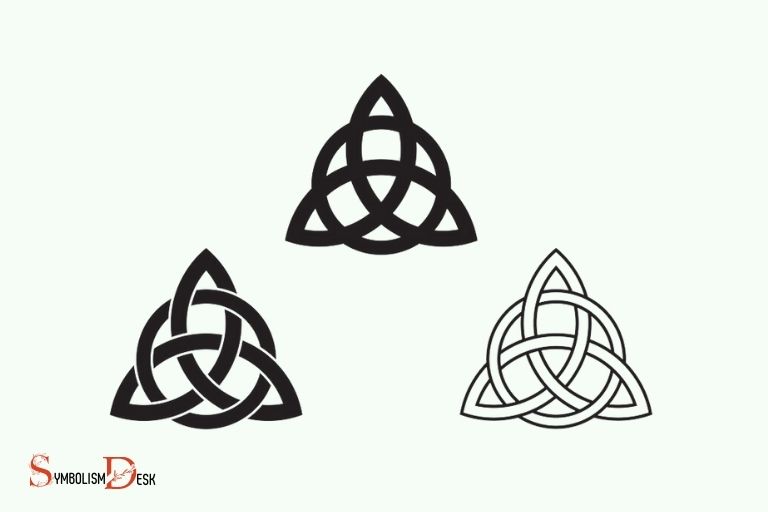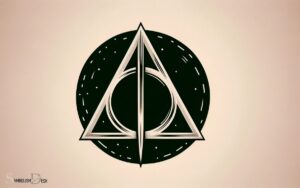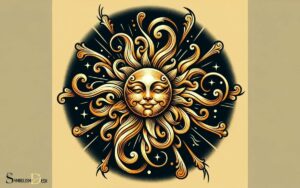What Does the Celtic Knot Mean Or Symbolize? Eternity!
The Celtic knot, also known as the endless knot, symbolizes the interconnectedness of life and eternity. In Celtic tradition, it represents the infinite cycles of birth and rebirth in both physical and heavenly realms.
The Celtic knot is a decorative, symbolic design that first appeared around the 3rd or 4th century AD.
They are a series of loops and knots that have neither a beginning nor an end, signifying the cyclical nature of life and the interconnectedness of all things. It is a profound symbol that holds deep spiritual and philosophical meaning in Celtic culture.
In the Celtic tradition, the knot is seen as an emblem of enduring life, much like the continuous path that the knots form.
This design conveys the Celtic belief in the interconnectedness of life and eternity, serving as a visual metaphor for the cyclical nature of existence, where everything is connected and interwoven.
It reminds us of the infinite possibilities of life, the endless cycle of birth, death, and rebirth which form the core of many spiritual and philosophical beliefs.
8 Celtic Knot Meanings or Symbolisms
| Celtic Knot | Meaning or Symbolism |
|---|---|
| Triquetra or Trinity Knot | Represents the Holy Trinity: The Father, Son, and Holy Spirit. It’s also used to symbolize the natural elements of earth, air, and water. |
| Dara Knot | Symbolic of an oak tree’s root system, manifests strength, wisdom, and leadership. |
| Shield Knot | A symbol of protection and warding. It was commonly used in battle and placed on battle shields. |
| Sailor’s Knot | Symbolizes a bond that cannot be broken, typically representing love or friendship. |
| Love Knot | Represents eternal love, as its interconnected path has no beginning or end. |
| Solomon’s Knot | Represents the linking of wisdom and love, and the connection between the spiritual and physical world. |
| Celtic Cross | Symbolizes the bridge to higher energies and planes of existence in the universe. |
| Celtic Spiral Knot | Represents the concept of growth, expansion, and cosmic energy. It is also associated with the cycles of time and nature. |
Key Takeaway

Five Facts About: The Meaning and Symbolism of the Celtic Knot
What Are Celtic Knots?
Celtic knots are intricate patterns that have been used for centuries in art and design. These knots are made up of interlaced and looping designs that have no beginning or end. They are often used in jewelry, clothing, and home decor to represent various meanings.
Definition
Celtic knots are a form of decorative art that originated from the ancient celts. They are also known as the endless knot or mystic knot because they have no beginning or end. Celtic knots are made up of one continuous line that loops and twists around itself.
The knots are created by weaving one strand of material around another, usually with the use of intricate embroidery or braiding techniques.
Origin
The origin of celtic knots can be traced back to the early history of the celts. These knots were used by the celts in their art, jewelry, and literature. The celts believed that the knots represented the connection between all things in nature.
They also believed that the knots held the power of protection and good luck.
Evolution
Over time, celtic knots evolved and took on new meanings. In the middle ages, the knots were used in christian art to symbolize the holy trinity. The knots were also used in designs for stained-glass windows, tapestries, and manuscripts.
Today, celtic knots are still used to represent various meanings. Some common meanings include:
- Infinity or eternity
- Connection with nature
- Protection
- Good luck
- Love and friendship
Celtic knots are a beautiful and meaningful form of art that have stood the test of time. They continue to inspire and captivate people all over the world.
The Symbolism Of Celtic Knots
Celtic knots are an important aspect of ancient celtic art and culture, and the intricate designs carry a deep meaning.
The timeless beauty of the knots has made them popular in modern times as well. The twisting and intertwining patterns have been used in various artistic mediums such as jewelry and tattoos, and are often admired for their mesmerizing appeal.
But, do you know what the celtic knots actually symbolize? Let’s dive into the symbolism of celtic knots under the subheadings: religious significance, cultural significance, and mythical significance.
Religious Significance
- Celtic knots were created by the celts, who were deeply connected to nature and believed in a complex system of divine powers.
- The knots were often used to decorate books and manuscripts, which contained important religious texts.
- The intricate designs of the knots were believed to symbolize the interconnectedness of life, and the infinite nature of the universe.
- The knots were also used to represent the holy trinity of christianity, signifying the father, son and holy spirit.
Cultural Significance
- The celts were tribes from central europe who migrated to britain and ireland. They developed their own distinct culture, which is still celebrated in modern-day ireland through festivals such as st. patrick’s day.
- Celtic knots were used to represent the continuity of life, nature, and the interconnectedness of all things.
- The knots were also seen as a symbol of loyalty and love between two people, which is why they were often used in engagement and wedding rings.
- The artwork was also used as a form of rebellion against the invading romans and other conquerors who sought to destroy celtic culture.
Mythical Significance
- Celtic knots were believed to hold magical powers and were often used in pagan rituals and ceremonies.
- The knots were used to represent the cycles of life, death, and rebirth, which were central themes in celtic mythology.
- The knots were also used to symbolize the connection between heaven and earth, and the eternal nature of the soul.
- The artwork was believed to protect against evil spirits and bring good fortune to the wearer.
Celtic knots are an intricate art form with a deep and complex set of meanings.
The knots have played an important role in religious, cultural, and mythical contexts, and have influenced art and design across the centuries. The continuing popularity of celtic knots attests to their timeless appeal and significance.
Triquetra
The triquetra is a popular celtic knot symbol that holds significant meaning and history. This symbol has been designated as one of the oldest and most profound symbols in celtic culture, with its roots dating back to the early centuries of celtic history.
Meaning And Significance
The triquetra consists of three interlaced loops that are generally symbolic of the three elements of nature – earth, air, and water.
However, this celtic knot symbol is open to interpretation, and the meaning behind the triquetra varies depending on the person and their cultural beliefs.
Some of the most widely recognized meanings of the triquetra are as follows:
- The holy trinity: The triquetra is often associated with christianity and is recognized as a symbol of the holy trinity – the father, son, and holy spirit.
- The circle of life: The three interlaced loops of the triquetra symbolize the cycle of life, death, and rebirth.
- Power of three: The number three holds significant importance in celtic culture and mythology. The three corners of the triquetra represent the three aspects of the triple goddess – the maiden, the mother, and the crone.
Variations
While the triquetra consists of three interlaced loops, there are several variations of this symbol that are recognized in celtic and modern culture.
Some of the most popular variations of the triquetra include:
- The trinity knot: Also known as the triquetra, this celtic knot symbol has come to represent christianity and the holy trinity.
- The knot of eternity: The triquetra can be used as a symbol of eternal love due to its interlacing loops that have no beginning or end.
- The celtic shield knot: This variation of the triquetra symbolizes protection, as the loops of the shield knots are believed to protect against evil spirits.
The triquetra is a symbol with deep-rooted meanings and significance. Its origins may be celtic, but its interpretation and usage have transcended into different cultures and religions.
Whether it represents nature, the holy trinity, or the cycle of life and death, the triquetra remains a powerful symbol and reminder of the interconnectedness of all things.
Dara Knot
The dara knot is a celtic symbol that has been around for centuries. This unique knot has a distinctive design that is instantly recognizable, and it has a deep meaning that resonates with many people today.
Meaning And Significance
The dara knot is derived from the word “dair,” which means oak in gaelic. The knot is created by weaving together the branches of the oak tree, which is a symbol of strength and endurance.
Here are a few key points about the meaning and significance of the dara knot:
- Represents strength and stability: The oak tree is known for its strength and durability, and the dara knot is a representation of those qualities. It is a symbol of stability in times of change and uncertainty.
- Symbolizes growth and wisdom: The oak tree is also associated with growth and wisdom. Its roots run deep, and it has the ability to weather any storm. The dara knot represents the importance of personal growth and the wisdom that comes with experience.
- Signifies protection: In celtic mythology, the oak tree was seen as a protective force, guarding against negative influences. The dara knot is a symbol of that same protective energy.
- Connected to the earth: The oak tree is deeply rooted in the earth, and the dara knot represents that connection. It is a reminder to stay grounded and connected to the earth.
Variations
Like many celtic symbols, the dara knot has numerous variations.
Here are a few examples:
- Double dara knot: The double dara knot is two dara knots woven together. This symbolizes the strength that comes from working together to achieve a common goal.
- Four-pointed dara knot: The four-pointed dara knot has four points instead of the usual three. Each point represents a different element: earth, air, fire, and water.
- Celtic cross with dara knot: The celtic cross with dara knot combines the dara knot with the celtic cross, which is a symbol of christianity. This represents the blending of celtic and christian traditions.
The dara knot is a powerful symbol that has been around for centuries. It represents strength, growth, wisdom, protection, and our connection to the earth. Its variations offer even more depth to its meaning and significance.
Whether you choose to wear a piece of jewelry with the dara knot or simply use it as a decorative element, it is a symbol that will continue to resonate with people for generations to come.
Trinity Knot
The trinity knot is undoubtedly one of the most recognizable symbols in celtic culture. It’s no wonder why; the knot is intricate yet simple, steeped in meaning and rich in history.
For those unfamiliar, the trinity knot is a never-ending intertwined design that’s often used to represent the holy trinity in christianity.
But this is not the extent of its symbolic significance. Let’s explore the meaning and variations of the trinity knot further to gain a deeper understanding.
Meaning And Significance
The trinity knot has existed for thousands of years, and its meaning has shifted and transformed over time.
Here are some essential points:
- The three points in the knot represent the father, son, and holy spirit. These three elements are the central components of the holy trinity, with god represented as one entity in three different forms.
- To many celts, the knot symbolizes the interconnectedness of life. There is no discernible beginning or end to the knot, making it an excellent symbol for the cyclical nature of existence.
Variations
The trinity knot has been used in various art forms such as jewelry, tattoos, and even home decor.
Here are some variations of the knot:
- Dara knot: This type of trinity knot features an oak tree sprouting from the center of the design, making it a symbol of strength and endurance.
- Triquetra: This variation of the knot features a circle woven around the intertwining lines. The circle is often interpreted as a representation of the natural world, or a cycle of time.
- Celtic shield knot: This version of the trinity knot is encased within a circle, and has been used to signify protection and warding off evil.
As you can see, there’s more to the trinity knot than just being a religious symbol. It’s a symbol of unity, strength, and interconnectedness.
Its various forms continue to inspire people around the world, and as one of the most ancient and meaningful celtic symbols, its significance will continue to endure. Its intricate design and timeless appeal make it a symbol of unity, eternity, and interconnectedness. Interestingly, the concept of symbolism extends beyond ancient motifs to modern interpretations, such as the emblematic tree in branding. For instance, the timberland logo meaning explained demonstrates how a simple image can embody values like strength, resilience, and a deep connection to nature.
Celtic Knots In Art History
Celtic knots are a popular design element in celtic art, dating back to the 5th century. These intricate designs are characterized by a series of overlapping knots that appear to have no beginning or end.
Celtic knots were used in a variety of ways in art and had different meanings depending on their design.
Here are some key points about the use of celtic knots in art.
Use Of Celtic Knots In Art
- Celtic knots were featured in illuminated manuscripts and stone carvings.
- They were used in jewelry and other decorative objects such as pottery and textiles.
- The knots were often used to symbolize the interconnectedness of all things and the cyclical nature of life.
Popular Celtic Knot Artworks
Some of the most well-known celtic knot artworks include:
- Book of kells: This is one of the most famous illuminated manuscripts in the world. It was created by celtic monks around 800 ad and features intricate celtic knot designs on its pages.
- Ardagh chalice: This is an ornate silver cup that was discovered in ireland in 1868. It dates back to the 8th century and features intricate celtic knot designs.
- Tara brooch: This is a stunning piece of jewelry that dates back to the 8th century. The brooch features intricate celtic knot designs and is embellished with gemstones.
Celtic knots continue to be popular design elements in art today, with many artists incorporating them into their work. Their timeless design and rich symbolism ensure that they will remain an essential part of celtic art for years to come.
Celtic Knots In Literature
Celtic knots have a rich history and have been used in various forms of art and literature. In literature, these knots have been used to symbolize endless love, loyalty, and eternity.
Celtic knots in literature were used as a device to create an intricate and visually pleasing design and to depict the essence of the story or characters.
Celtic Knots In Mythology
Celtic knots have their roots in ancient celtic mythology. The knots were used to depict the cycles of life and death, and the interconnectedness of all living things.
The knots were also used to depict the complex relationships between gods, goddesses, and humans.
For example, the triple spiral knot represents birth, life, and death, and also the maiden, the mother, and the crone.
Contemporary Interpretation Of Celtic Knots
In contemporary literature, celtic knots have been used to represent timeless themes such as love, loyalty, and hope.
They are also used to depict the interconnectedness of life and the idea that what we do in this life affects the next.
One of the most popular contemporary interpretations of celtic knots is the claddagh ring. The claddagh symbol features two hands holding a heart, topped with a crown. It represents love, loyalty, and friendship.
Here are some other contemporary interpretations of celtic knots:
- The trinity knot represents the holy trinity and symbolizes eternity and the interconnectedness of three elements.
- The shield knot represents strength and protection.
- The spiral knot represents growth, expansion, and transformation.
- The tree of life knot is a symbol of the interconnection of all living beings, as well as growth, family, and continuity.
Celtic knots in literature have a rich history and symbolize themes such as love, loyalty, and interconnectedness. From ancient mythology to contemporary interpretations, these knots have played a significant role in storytelling.
Celtic Knots In Contemporary Design
Celtic knots are intricate designs that have captured the imaginations of people worldwide.
These knots have been utilized in contemporary design in many ways, including fashion design, graphic design, and interior design. Let’s take a closer look at how these knots are used in each design category.
Fashion Design
Celtic knots are amazing designs that can be adapted to suit countless styles. That is what makes them so universal in fashion design. They can be incorporated into any garment or accessory like shoes, bags, and jewelry.
Here are some of the key points about their use in fashion design:
- They can be used in unique ways, such as in the laces of a dress or as intricate patterns on a dress.
- Celtic knots can lend a traditional feel to designs or be used in more modern, contemporary looks.
- They can be used in various colors and materials, ranging from gold to rubber.
Graphic Design
Celtic knots can be manipulated in numerous ways in graphic design. They can be used to create logos for companies or as intricate designs in artwork.
Here are some points about their use in graphic design:
- They can be used to make abstract designs, borders, and even whole patterns.
- They can play off of negative space, with the knot being the only solid line in the design.
- They can be found in packaging design, website designs, and even tattoo designs.
Interior Design
Celtic knots can add intricate designs to any place in your home. They work well on walls, floors, and even in furniture design.
Here are some key points about their use in interior design:
- Celtic knots can be added to any modern, traditional or contemporary home design.
- They can be featured as wallpapers, woven into tapestries, as decor pieces, or etched in glass and wood.
- They are versatile and can be incorporated in bright colors or used in muted shades.
Celtic knots are ancient designs that are still impactful in contemporary design. From fashion to graphic design to interior design, the design possibilities are endless, making them an essential design element for years to come.
Celtic Knots In Modern Culture
The celtic knot is an ancient symbol that has been used in many cultures, including the celtic, norse, and christian traditions.
Today, the celtic knot continues to be a beloved symbol, not only for people with irish or scottish heritage but for people all around the world.
Popularity In Different Cultures
The celtic knot has become increasingly popular in different cultures across the globe.
Here are some of the key points about the knot’s popularity:
- The knot is beloved for its never-ending pattern, which can represent eternal love, infinity, and interconnectedness.
- The knot is often used in wedding bands and engagement rings for this reason.
- People of all backgrounds wear jewelry and clothing with celtic knot designs, as the knot’s elegance and beauty appeal to all.
- The knot has also become popular in tattooing, with people getting various versions of the knot on their bodies.
Meaning And Significance In Today’s Society
Today, the celtic knot continues to be a meaningful symbol in modern society.
Here are some of the key points about the knot’s contemporary significance:
- The knot is used to represent interconnectedness and oneness with the universe, making it an ideal symbol for those interested in spirituality and nature.
- The knot’s design is also used in modern architecture and fashion to add a touch of elegance and sophistication.
- The knot’s popularity continues to inspire artists and designers to create new and innovative designs, blending ancient celtic symbolism with modern aesthetics.
- The knot remains an important symbol for people of irish or scottish heritage, connecting them with their rich cultural and historical roots.
FAQ About on The Celtic Knot Mean Or Symbolize
What Is The Meaning Behind Celtic Knots?
Celtic knots are symbolic representations of eternity and interconnectedness.
What Do The Different Knot Designs Signify?
Different knot designs have different meanings, often representing aspects of nature or emotions.
What Cultures Use The Celtic Knot In Their Symbolism?
The celtic knot is primarily associated with the celtic and norse cultures.
What Materials Were Traditionally Used For Celtic Knot Jewelry?
Traditional celtic knot jewelry was often made from silver, gold, or bronze.
Can Celtic Knots Be Customized For Personal Significance?
Yes, personalized celtic knot designs can feature specific symbols or colors with personal significance.
Conclusion
The celtic knot has been an integral part of celtic culture for centuries, and its intricate interwoven design continues to captivate people even today.
For the celts, the knot represented the endless cycles of life and death, and the interconnectedness of all things in the universe.
It was also used as a protective charm against evil forces and a symbol of love and unity. Despite its ancient origins, the celtic knot remains a meaningful symbol in the modern world, often used to represent the interconnectedness of humanity and the continuity of life.
Its popularity shows no signs of waning, and continues to inspire and intrigue people around the world. Whether you are drawn to its aesthetic beauty or its spiritual significance, the celtic knot remains a powerful symbol that speaks to the human experience and the mysteries of life.






